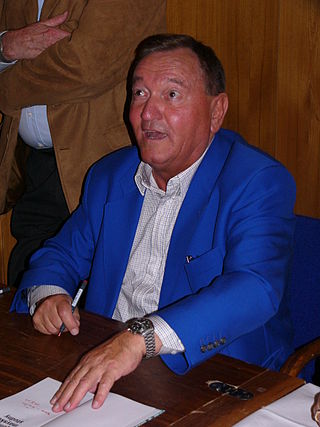
Alien invasion or space invasion is a common feature in science fiction stories and film, in which extraterrestrial lifeforms invade the Earth to exterminate and supplant human life, enslave it, harvest people for food, steal the planet's resources, or destroy the planet altogether. It can be considered as a science-fiction subgenre of the invasion literature, expanded by H. G. Wells's seminal alien invasion novel The War of the Worlds, and is a type of "first contact" science fiction.
Zecharia Sitchin was an author of a number of books proposing an explanation for human origins involving ancient astronauts. Sitchin attributed the creation of the ancient Sumerian culture to the Anunnaki, which he stated was a race of extraterrestrials from a planet beyond Neptune called Nibiru. He asserted that Sumerian mythology suggests that this hypothetical planet of Nibiru is in an elongated, 3,600-year-long elliptical orbit around the Sun. Sitchin's books have sold millions of copies worldwide and have been translated into more than 25 languages.
A sleeper ship is a hypothetical type of crewed spacecraft, or starship in which most or all of the crew spend the journey in some form of hibernation or suspended animation. The only known technology that allows long-term suspended animation of humans is the freezing of early-stage human embryos through embryo cryopreservation, which is behind the concept of embryo space colonization.

The Berserker series is a series of space opera science fiction short stories and novels by Fred Saberhagen, in which robotic self-replicating machines strive to destroy all life.

Erich Anton Paul von Däniken is a Swiss author of several pseudoscientific books which make claims about extraterrestrial influences on early human culture, including the best-selling Chariots of the Gods?, published in 1968. Von Däniken is one of the main figures responsible for popularizing the "paleo-contact" and ancient astronauts hypotheses.

Ancient astronauts refer to a pseudoscientific set of beliefs that hold that intelligent extraterrestrial beings visited Earth and made contact with humans in antiquity and prehistoric times. Proponents suggest that this contact influenced the development of modern cultures, technologies, religions, and human biology. A common position is that deities from most, if not all, religions are extraterrestrial in origin, and that advanced technologies brought to Earth by ancient astronauts were interpreted as evidence of divine status by early humans.

A humanoid is a non-human entity with human form or characteristics. By the 20th century, the term came to describe fossils which were morphologically similar, but not identical, to those of the human skeleton.

Chariots of the Gods? Unsolved Mysteries of the Past is a book written in 1968 by Erich von Däniken and translated from the original German by Michael Heron. It involves the hypothesis that the technologies and religions of many ancient civilizations were given to them by ancient astronauts who were welcomed as gods.
The concept of self-replicating spacecraft, as envisioned by mathematician John von Neumann, has been described by futurists and has been discussed across a wide breadth of hard science fiction novels and stories. Self-replicating probes are sometimes referred to as von Neumann probes. Self-replicating spacecraft would in some ways either mimic or echo the features of living organisms or viruses.
Xenoarchaeology, a branch of xenology dealing with extraterrestrial cultures, is a hypothetical form of archaeology that exists mainly in works of science fiction. The field is concerned with the study of the material remains to reconstruct and interpret past life-ways of alien civilizations. Xenoarchaeology is not currently practiced by mainstream archaeologists due to the current lack of any material for the discipline to study.

In Arthur C. Clarke's Space Odyssey series, Monoliths are machines in black cuboids whose sides extend in the precise ratio of 1 : 4 : 9 (12 : 22 : 32) built by an unseen extraterrestrial species whom Clarke dubbed the Firstborn and who he suggests are the earliest highly intelligent species to evolve in the Milky Way. In the series of novels (and the films based on these), three Monoliths are discovered in the Solar System by australopithecines and their human descendants. The characters' responses to their discoveries drives the plot of the series and influences its fictional history, particularly by encouraging humanity to progress with technological development.
The Noon Universe is a fictional future setting for a number of hard science fiction novels written by Arkady and Boris Strugatsky. The universe is named after Noon: 22nd Century, chronologically the first novel from the series and referring to humanity reaching its noon in the 22nd century.
The zoo hypothesis speculates on the assumed behavior and existence of technologically advanced extraterrestrial life and the reasons they refrain from contacting Earth. It is one of many theoretical explanations for the Fermi paradox. The hypothesis states that extraterrestrial life intentionally avoids communication with Earth to allow for natural evolution and sociocultural development, and avoiding interplanetary contamination, similar to people observing animals at a zoo. The hypothesis seeks to explain the apparent absence of extraterrestrial life despite its generally accepted plausibility and hence the reasonable expectation of its existence. A variant on the zoo hypothesis suggested by the former MIT Haystack Observatory scientist John Allen Ball is the "laboratory" hypothesis, in which humanity is being subjected to experiments, with Earth serving as a giant laboratory.

The mythology of the Stargate franchise is a complex and eclectic fictional backstory, which is presented as being historical, of the Stargate premise. A "rich mythology and world-building" are used to establish "a vast cosmology and an interesting alternate take on the history of Earth"; a defining feature is "its use of ancient mythology, with stories that take inspiration from multiple places around the globe". Narratives center around xeno-mythology as experienced by humans during episodic contact with alien races. Audiences across a variety of platforms - including TV series, novels, comics and movies - witness the people of Earth exploring a fictional universe using the Stargate. Species established early on in the franchise recur throughout, with one adversary often dominating a particular story arc, which can continue across several seasons.
The use of nanotechnology in fiction has attracted scholarly attention. The first use of the distinguishing concepts of nanotechnology was "There's Plenty of Room at the Bottom", a talk given by physicist Richard Feynman in 1959. K. Eric Drexler's 1986 book Engines of Creation introduced the general public to the concept of nanotechnology. Since then, nanotechnology has been used frequently in a diverse range of fiction, often as a justification for unusual or far-fetched occurrences featured in speculative fiction.

The Martians, also known as the Invaders, are the main antagonists from the H.G. Wells 1898 novel The War of the Worlds. Their efforts to exterminate the populace of the Earth and claim the planet for themselves drive the plot and present challenges for the novel's human characters. They are notable for their use of extraterrestrial weaponry far in advance of that of mankind at the time of the invasion.

Ancient Aliens is an American television series produced by Prometheus Entertainment that explores the pseudoscientific hypothesis of ancient astronauts in a non-critical, documentary format. Episodes also explore related pseudoscientific and pseudohistoric topics, such as: Atlantis and other lost ancient civilizations, extraterrestrial contact and ufology, and popular conspiracy theories. The series, which has aired on History since 2010, has been a target for criticism of History's channel drift, as well as criticism for promoting unorthodox or unproven hypotheses as fact. According to Smithsonian, episodes of the series overwhelm the viewer with "fictions and distortions" by using a Gish gallop.

Jean Sendy (1910–1978) was a French writer and translator, author of works on esoterica and UFO phenomena. He was also an early proponent of the ancient astronaut hypothesis.
The Silurian hypothesis is a thought experiment which assesses modern science's ability to detect evidence of a prior advanced civilization, perhaps several million years ago. The most probable clues for such a civilization could be carbon, radioactive elements or temperature variation. The name "Silurian" derives from the eponymous sapient species from the BBC science fiction series Doctor Who, who in the series established an advanced civilization prior to humanity, not from the eponymous geological era.











